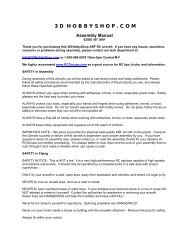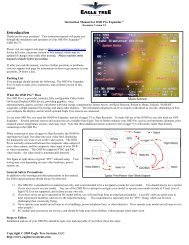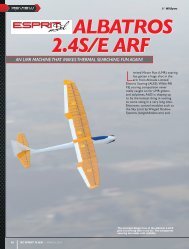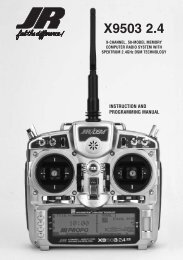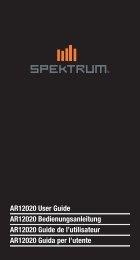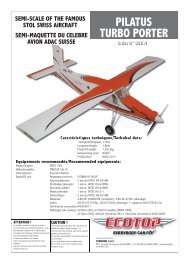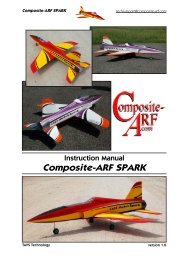You also want an ePaper? Increase the reach of your titles
YUMPU automatically turns print PDFs into web optimized ePapers that Google loves.
FCC Information<br />
This device complies with part 15 of the FCC rules.<br />
Operation is subject to the following two conditions:<br />
(1) This device may not cause harmful interference,<br />
and (2) this device must accept any interference<br />
received, including interference that may cause<br />
undesired operation.<br />
Caution: Changes or modifications not expressly<br />
approved by the party responsible for compliance<br />
could void the user’s authority to operate the<br />
equipment.<br />
This product contains a radio transmitter with<br />
wireless technology which has been tested<br />
and found to be compliant with the applicable<br />
regulations governing a radio transmitter in the<br />
2.400GHz to 2.4835GHz frequency range.<br />
ANTENNA SEPARATION DISTANCE<br />
When operating your Spektrum transmitter, please<br />
be sure to maintain a separation distance of at least<br />
5 cm between your body (excluding fingers, hands,<br />
wrists, ankles and feet) and the antenna to meet<br />
RF exposure safety requirements as determined by<br />
FCC regulations.<br />
The illustrations below show the approximate 5 cm<br />
RF exposure area and typical hand placement when<br />
operating your Spektrum transmitter.<br />
APPENDIX<br />
FLIGHT LOG <strong>JR</strong>PA145 - OPTIONAL<br />
FOR <strong>JR</strong> R921 ReCeIVeR<br />
The Flight Log is compatible with the <strong>JR</strong> R921 receiver and many other<br />
compatible receivers. The Flight Log displays overall RF link performance as well<br />
as the individual internal and external receiver link data. Additionally it displays<br />
receiver voltage.<br />
After a flight and before turning off the receiver or transmitter, plug the Flight Log<br />
into the Data port on the receiver. The screen automatically displays voltage e.g.,<br />
6v2= 6.2 volts .<br />
Note: When the voltage reaches 4.8 volts or less, the screen flashes indicating<br />
low voltage.<br />
Using the flight Log<br />
Press the button to display the following information:<br />
• A - Antenna fades on internal antenna A<br />
• B - Antenna fades on external antenna B<br />
• L - Antenna fades on the left external antenna<br />
• R - Antenna fades on the right external antenna<br />
• F - Frame loss<br />
• H - Holds<br />
Antenna fades—represents the loss of a bit of information on that specific antenna.<br />
It’s typical to have as many as 50 to 100 antenna fades during a flight.<br />
If any single antenna experiences over 500 fades in a single flight, reposition the<br />
antenna in the aircraft to optimize the RF link.<br />
Frame loss—represents simultaneous antenna fades on all attached receivers.<br />
If the RF link is performing optimally, frame losses per flight should be less than<br />
20.<br />
Holds are indicated when 45 consecutive frame losses occur.<br />
This takes about one second. If a hold occurs during a flight, it’s important to<br />
re-evaluate the system. Move the antennas to different locations and/or check to<br />
be sure the transmitter and receivers are working correctly.<br />
Note: You can use a servo extension to plug the Flight Log in without having<br />
to remove the aircraft’s hatch or canopy. On some models, the Flight Log can<br />
be plugged in, attached and left on the model using double-sided tape. This is<br />
common with helicopters, mounting the Flight Log conveniently to the side frame.<br />
ADvANCED RANGE TESTING<br />
Advanced Range Testing Using a flight Log<br />
For sophisticated aircraft that contain significant amounts of conductive materials<br />
(e.g., turbine-powered jets, some types of scale aircraft, aircraft with carbon<br />
fuselages, etc.) the following advanced range check confirms internal and remote<br />
receivers are operating optimally and the receiver installation is optimized for the<br />
specific aircraft. Before each flying session, and especially with a new model, it’s<br />
important to perform a range check. The <strong>11X</strong> incorporates a range testing system<br />
which, when the bind button on the transmitter is pressed and held, reduces the<br />
output power, allowing a range check.<br />
Plug a Flight Log (optional, <strong>JR</strong>PA145) into the data port in the receiver and turn<br />
on the system (Tx and Rx). Advance the Flight Log until F- frame losses display<br />
by pressing the button on the flight log.<br />
Have a helper hold your aircraft while observing the Flight Log data. Stand 30<br />
paces away from the model and helper. Face the model with the transmitter in<br />
your normal flying position and depress and hold the bind button on the back of<br />
the transmitter. This causes reduced power output from the transmitter.<br />
Have your helper position the model in various orientations (nose up, nose down,<br />
nose toward the transmitter, nose away from the transmitter, etc.) while watching<br />
the Flight Log. Note any correlation between the aircraft’s orientation and Frame<br />
Losses. Do this for 1 minute. You can use the timer on the transmitter.<br />
For giant-scale aircraft, tip the airplane up on its nose and rotate it 360 degrees<br />
for one minute then record the data. Next place the airplane on its wheels and do<br />
a second test rotating the aircraft in all directions for one minute. After one minute<br />
release the bind button. A successful range check will have less than ten recorded<br />
frame losses.<br />
Scrolling the Flight Log through the Antenna fades (A, B, L, R) allows you to<br />
evaluate the performance of each receiver. Antenna fades should be relatively<br />
uniform. If a specific antenna is experiencing a high degree of fades, then that<br />
antenna should be moved to a different location.<br />
A successful Advanced test yields the following:<br />
• H- 0 holds<br />
• F- Less than 10 frame losses<br />
• A, B, R, L- Frame losses will typically be less than 100.<br />
It’s important to compare the relative frame losses. If a particular receiver has a<br />
significantly higher frame loss value (2X to 3X), redo the test. If the same results<br />
occur, move the offending receiver to a different location.<br />
CONTROL STICK TENSION<br />
ADJUSTMENT<br />
Stick tension adjustments are accessible by removing the back half of the<br />
transmitter case. Remove the 6 screws with a medium Phillips screwdriver, then<br />
carefully pull the back half of the transmitter case off gently. Set the case to the<br />
side using care to not damage the wires. Using a small Phillips screwdriver,<br />
adjust each gimbals’ tension screw for the desired tension (counterclockwise to<br />
loosen stick tension; clockwise to tighten stick tension).<br />
1. elevator 3. Rudder<br />
2. Aileron 4.Throttle Tension Adjustment<br />
Control Stick Length<br />
Use a 2mm Allen wrench to unlock the setscrew to adjust the stick length. Turn<br />
the wrench counterclockwise to loosen the screw. Then, turn the stick clockwise<br />
to shorten or counterclockwise to lengthen the overall stick length. After the<br />
control stick length has been adjusted to suit your flying style, tighten the 2mm<br />
setscrew. If you desire longer sticks, <strong>JR</strong> offers a stick (<strong>JR</strong>PA047) approximately<br />
one inch longer than standard, and has various length anodized aluminum stick<br />
ends available (<strong>JR</strong>PA040-<strong>JR</strong>PA045). These stick ends are crafted from bar stock<br />
aluminum, and are available at your local <strong>JR</strong> dealer.<br />
Neck Strap Attachment<br />
The face of the <strong>11X</strong> transmitter has an eyelet for connecting a Neck Strap.<br />
42 <strong>JR</strong> <strong>11X</strong> • RADIO INSTRUCTION MANUAL <strong>JR</strong> <strong>11X</strong> • RADIO INSTRUCTION MANUAL<br />
43<br />
1.<br />
2.<br />
4.<br />
3.



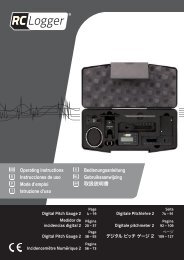
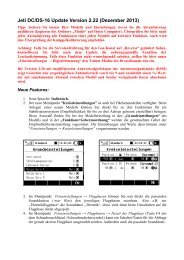

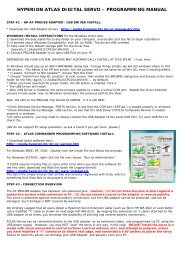

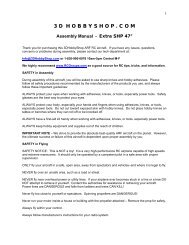
![P01(Oxalys EP) [更新済み].ai - Kyosho](https://img.yumpu.com/26948574/1/184x260/p01oxalys-ep-ai-kyosho.jpg?quality=85)
